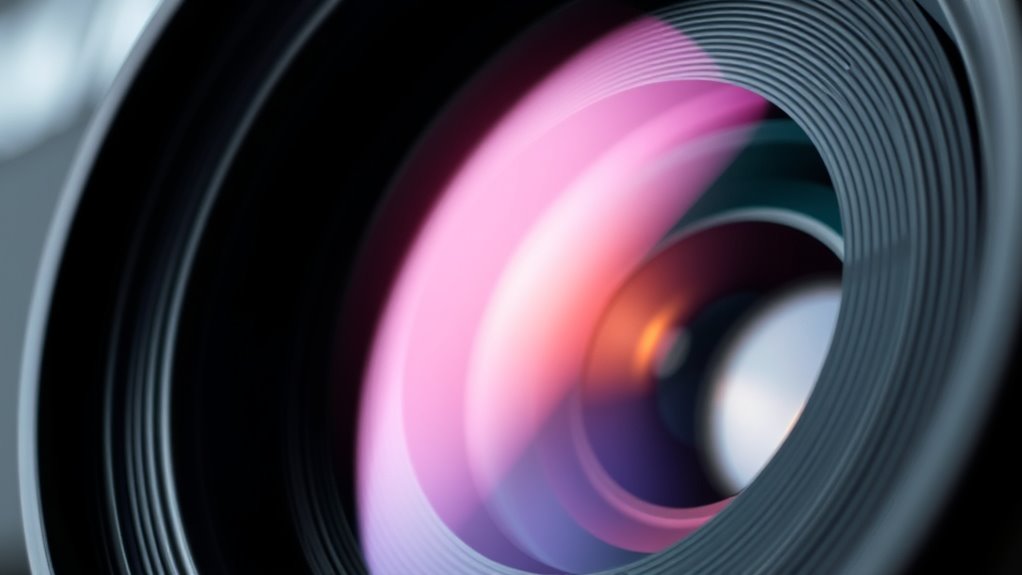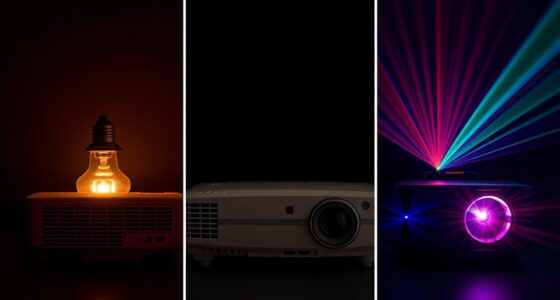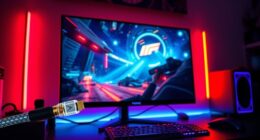Pixel shifting is a simple technique that boosts image resolution and stability by slightly moving the sensor or image projection between shots, capturing multiple detailed images to create sharper, more vibrant displays. It helps improve color accuracy, reduce artifacts, and enhance overall image quality. While it offers benefits like decreased screen distortion, it can also have limitations, such as increased processing demands. For a clear understanding of how it works and how to use it, keep exploring further.
Key Takeaways
- Pixel shifting enhances image resolution by moving the sensor or image slightly between shots to capture finer details.
- It reduces artifacts like color fringing, banding, and motion blur, improving overall display clarity.
- Requires compatible hardware, stable setup, and software calibration for optimal results.
- Benefits include sharper images, better color accuracy, and reduced screen burn-in, but may increase processing demands.
- Limitations involve hardware compatibility, potential latency in gaming, and possible performance trade-offs.
What Is Pixel Shifting and How Does It Work?
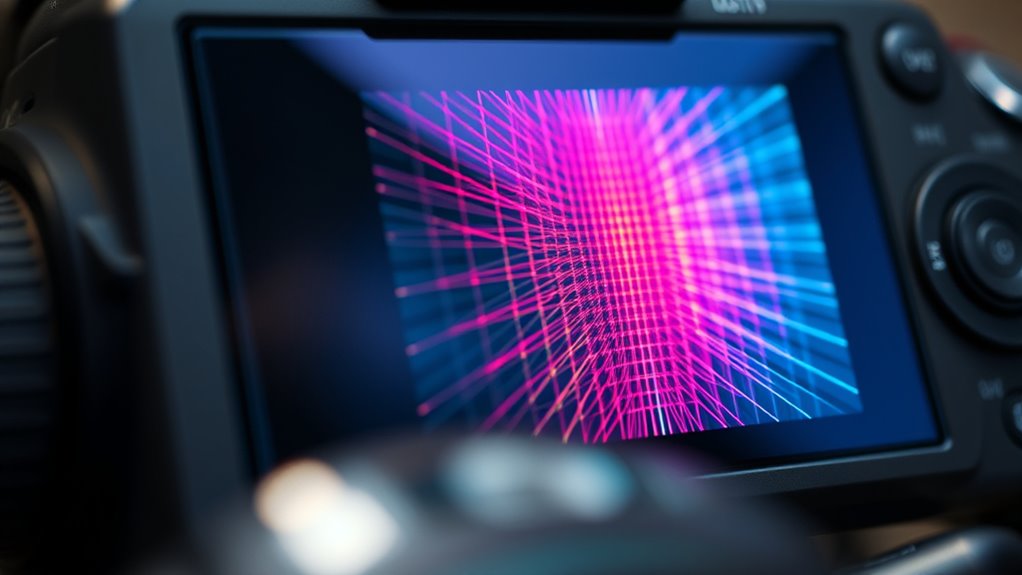
Pixel shifting is a technique used in digital imaging to enhance resolution and detail. It works by slightly moving the image sensor or the projected image in tiny, precise steps between shots. This process captures multiple images, each with subtle shifts, allowing the camera to gather more information than a single shot. When combined, these images produce a higher-resolution result with finer details. Pixel shifting also contributes to image stabilization by reducing blurriness caused by hand movement or vibrations. This technique effectively compensates for minor camera shakes, resulting in sharper, clearer pictures. By leveraging pixel shifting, devices can deliver images with improved resolution enhancement and stability, making photos look more professional and detailed without needing higher-end hardware. Additionally, understanding the contrast ratio in projectors can help optimize image quality for different viewing environments.
Why Do Devices Use Pixel Shifting?
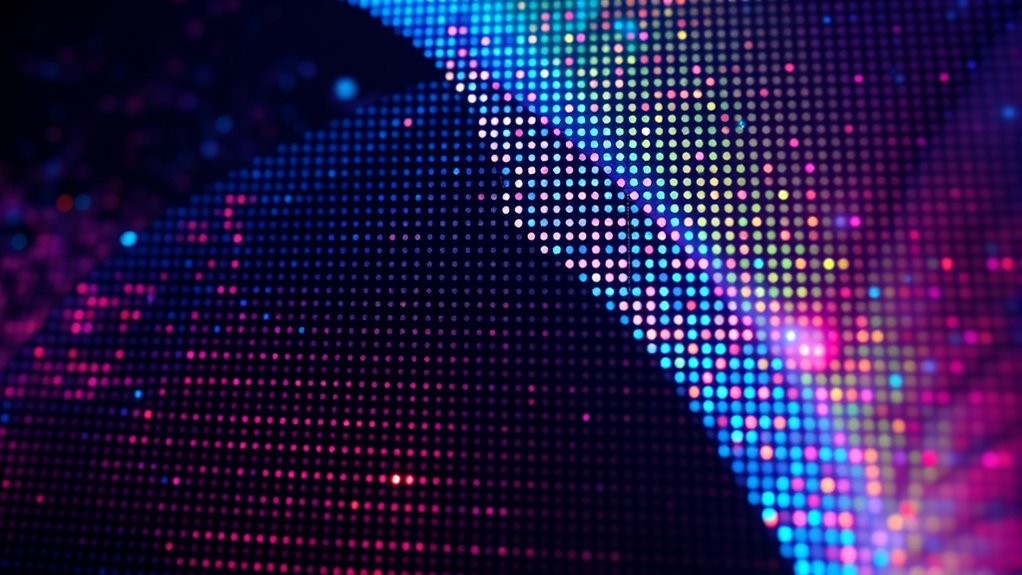
Devices use pixel shifting to make images look sharper and more detailed on screens. It also helps reduce screen artifacts that can distract or cause visual issues. By doing so, your viewing experience becomes clearer and more comfortable. This technique is similar to how smart indoor gardens optimize visual displays to enhance user interaction and experience.
Enhances Image Resolution
Have you ever wondered why camera technology employs pixel shifting? The main goal is resolution enhancement, allowing your images to appear sharper and more detailed. When a device uses pixel shifting, it captures multiple images with slight sensor movements, effectively gathering more color and detail information than a single shot. This process improves image clarity by reducing blurring and pixelation, especially in high-resolution displays. Pixel shifting makes it possible to produce images with finer detail without needing a physically larger sensor. It’s particularly useful in professional photography and high-end consumer devices, where every pixel counts. By increasing the effective resolution, pixel shifting ensures your photos look crisp, vibrant, and true to life, elevating your overall viewing experience. Additionally, techniques like Glycolic Acid benefits for skin demonstrate how advanced imaging and skin care innovations aim to improve quality and clarity in their respective fields.
Reduces Screen Artifacts
By shifting pixels slightly between images, manufacturers can substantially reduce screen artifacts such as color fringing, banding, and motion blur. This is the core benefit of the pixel shifting technique for screen artifact reduction. It helps create cleaner, more accurate images by minimizing visual distortions caused by pixel limitations. Additionally, pixel shifting can enhance overall image stability, leading to a more consistent viewing experience. Image quality is improved as a result of these combined benefits, making screens appear sharper and more vibrant.
Can Pixel Shifting Improve Image Quality on My Screen?

Pixel shifting can markedly enhance image quality on your screen by reducing visual artifacts and improving sharpness. It helps deliver more accurate color reproduction, making images look richer and more lifelike. By compensating for pixel limitations, pixel shifting also supports better motion smoothing, which creates smoother transitions during fast-moving scenes. This technique minimizes blurring and ghosting, resulting in clearer, more detailed images. If your display supports pixel shifting, you’ll notice crisper text, sharper graphics, and more vibrant colors. It’s especially beneficial for high-resolution screens where pixel imperfections become more apparent. Additionally, advancements in AI technology are contributing to more sophisticated pixel correction methods, further enhancing display quality. Overall, pixel shifting can considerably elevate your viewing experience by refining image clarity and color accuracy, making your screen’s output more vibrant and true to life.
What Equipment Is Needed to Utilize Pixel Shifting?
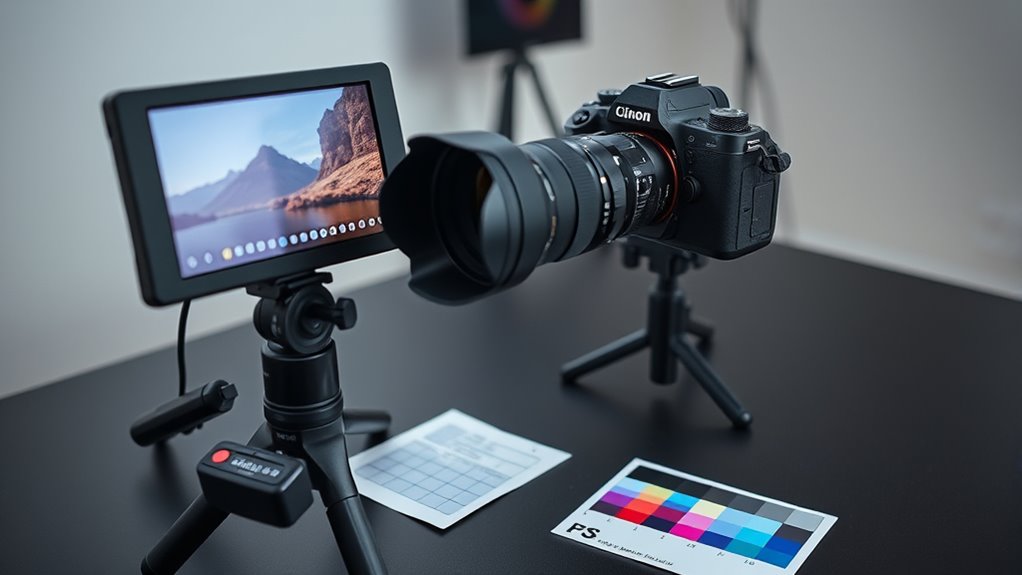
To get started with pixel shifting, you’ll need a compatible camera model that supports this feature. Additionally, you should gather essential accessories like a sturdy tripod and remote shutter release to guarantee precise image capture. Having the right equipment ensures you can effectively utilize pixel shifting for improved image quality. Using a high-quality sprayer can also help achieve more consistent results when applying paint or finishes.
Compatible Camera Models
Wondering which cameras can support pixel shifting? It’s vital to choose models that can handle precise sensor movements and maintain image quality. Many modern mirrorless and DSLR cameras are compatible, but you should verify lens compatibility and support for display calibration to get the best results.
Key points to take into account include:
- Compatibility with your camera’s firmware and software updates
- Ability to perform accurate sensor shifts without affecting image quality
- Support for display calibration to ensure pixel-shifted images are accurately rendered
Not all cameras support pixel shifting, so check the manufacturer’s specifications. Making sure your camera can handle these requirements will help you achieve sharp, high-res images without compromising on performance or calibration.
Essential Accessories Needed
Utilizing pixel shifting effectively requires a few essential pieces of equipment to guarantee accurate sensor movements and high-quality results. First, you’ll need a stable tripod or mount to keep your camera perfectly steady during image capture, ensuring precise sensor shifts. A camera with reliable stabilization features helps maintain alignment. To achieve ideal color accuracy, ensure your display is properly calibrated, which helps in reviewing and editing images accurately. Display calibration tools are crucial for consistent color reproduction across devices. Additionally, a remote shutter release prevents camera shake during shooting, maintaining sharpness. While not mandatory, software that aligns and stacks images can enhance results further. Having these accessories ensures your pixel-shift process is precise, resulting in superior detail, color fidelity, and overall image quality. Moreover, understanding the cultural impact of technology on artistic expression can help you better interpret the results and improve your creative workflow.
Are There Any Downsides or Limitations to Pixel Shifting?
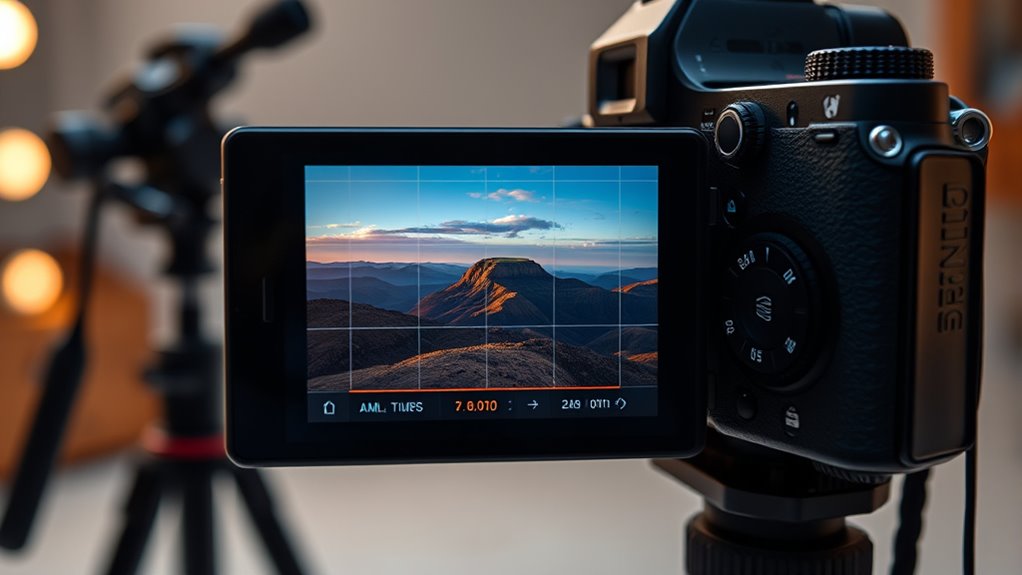
While pixel shifting can enhance image quality, it also has some limitations to contemplate. One concern is performance trade-offs; using pixel shifting may require more processing power, which can slow down your device or reduce battery life. Additionally, hardware compatibility is vital—if your display or graphics card doesn’t support pixel shifting properly, you might not see any benefits or could encounter glitches. As AI technology continues to evolve, market growth projected at over 40% CAGR in AI tech by 2025 highlights the increasing reliance on advanced hardware, which may influence compatibility issues. Some limitations include:
- Increased processing demands that could impact overall performance
- Dependence on compatible hardware for ideal results
- Potential issues with motion artifacts or ghosting during fast scenes
Understanding these downsides helps you weigh the benefits against possible performance trade-offs and hardware constraints before enabling pixel shifting.
How Do I Enable or Set Up Pixel Shifting on My Device?
To enable or set up pixel shifting on your device, start by checking if your display or graphics card supports the feature. If supported, you’ll need to follow specific calibration procedures, which guarantee the pixel shifting works correctly. Access your device’s display settings or the graphics card’s control panel to find pixel shifting options. You might need to enable the feature manually within the software configuration, often found in advanced display settings. Follow the manufacturer’s instructions for proper calibration, adjusting any sliders or parameters as needed. Once set, test the display to confirm pixel shifting activates smoothly. Proper setup ensures peak image quality and prevents artifacts, giving you the best experience without complications. Additionally, understanding display calibration techniques can help optimize your device’s performance and image accuracy.
Is Pixel Shifting Suitable for Gaming, Watching Movies, or Professional Work?
Pixel shifting can be suitable for gaming and watching movies if your device is properly calibrated, but its effectiveness depends on the specific application. For gaming performance, pixel shifting may improve visual sharpness, but it can also introduce latency issues, affecting responsiveness. When watching movies, pixel shifting can enhance the overall viewing experience by delivering more detailed images and smoother motion. However, it might not be ideal for professional work that requires precise color accuracy or pixel-level detail. Consider these points:
Pixel shifting can improve viewing quality but may introduce latency, making it less ideal for professional work.
- It may boost perceived image quality during casual gaming or movie viewing
- Not suitable for tasks demanding exact color fidelity or pixel precision
- Results vary depending on the content and device calibration
- Local laws and regulations can influence the effectiveness and acceptance of certain display technologies.
Decide based on your priorities: enhanced entertainment or professional accuracy.
Does Pixel Shifting Have Any Impact on Power Consumption or Longevity?
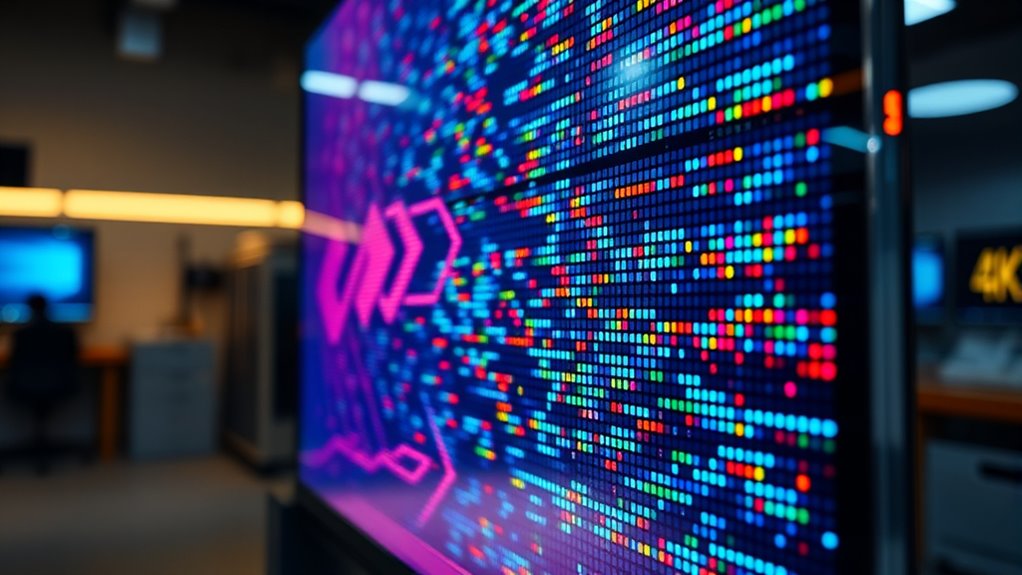
Implementing pixel shifting can influence your device’s power consumption and longevity. Since pixel shifting involves moving the image slightly to reduce burn-in, it may cause your device to work a bit harder, increasing power usage slightly. However, this increase is typically minimal and shouldn’t substantially impact overall power consumption. As for device longevity, pixel shifting can actually help extend the lifespan of your display by preventing burn-in and static image retention. By regularly moving pixels, it reduces the risk of permanent damage caused by static images over time. Overall, while pixel shifting may cause a tiny rise in power consumption, it offers a beneficial way to protect your device’s longevity, ensuring your screen remains in top condition over the long term.
Frequently Asked Questions
Can Pixel Shifting Cause Motion Sickness or Eye Strain?
Pixel shifting can cause visual discomfort and eye fatigue, especially if you’re sensitive to rapid image changes. You might experience motion sickness or eye strain because your eyes work harder to adjust to the shifting pixels. To minimize these issues, take regular breaks, adjust your display settings, or reduce the shifting intensity. If discomfort persists, it’s best to stop using pixel shifting to protect your eye health and comfort.
Does Pixel Shifting Work With All Types of Display Panels?
Pixel shifting doesn’t work with all display panel types. It’s most effective on LCDs with high refresh rates, typically 120Hz or higher, ensuring smooth motion. OLED and LED panels may have limited compatibility due to their different refresh rate capabilities. Check your display’s refresh rate compatibility before enabling pixel shifting, as using it on incompatible panels can cause visual artifacts or reduce overall display quality.
How Does Pixel Shifting Affect Color Accuracy?
You might notice that pixel shifting can slightly impact color fidelity, but it generally enhances image precision. The technique works by subtly moving pixels, which may cause minor shifts in color accuracy, especially in fast-moving scenes. However, most modern displays are designed to maintain excellent color accuracy during pixel shifting. Overall, it improves overall image quality without sacrificing essential color fidelity, providing a sharper, more precise viewing experience.
Is Pixel Shifting Compatible With External Monitors or Only Built-In Screens?
Pixel shifting is compatible with external monitors, but you need to ensure display calibration. Not all monitors support pixel shifting features, so check your monitor’s specifications. When using an external display, calibration ensures color accuracy and proper alignment, which can be affected by pixel shifting. Make sure your monitor’s firmware and settings allow for pixel shifting to avoid issues and get the best visual experience.
What Troubleshooting Steps if Pixel Shifting Causes Artifacts or Glitches?
If pixel shifting causes artifacts or glitches, start by checking for software conflicts that might interfere with display functions. Next, verify your display calibration is accurate, as improper settings can lead to issues. Update your graphics drivers and firmware to fix bugs. If problems persist, disable pixel shifting temporarily, then re-enable it after adjusting calibration. These steps help resolve glitches and restore smooth pixel shifting performance.
Conclusion
Now that you know the basics of pixel shifting, you can decide if it’s right for you. Remember, a tool is only as good as how you use it—so don’t be afraid to experiment and find what works best. Pixel shifting can boost your display’s clarity, but it’s not a magic fix. Like they say, “Practice makes perfect,” so take the time to learn its quirks and maximize your viewing experience.
